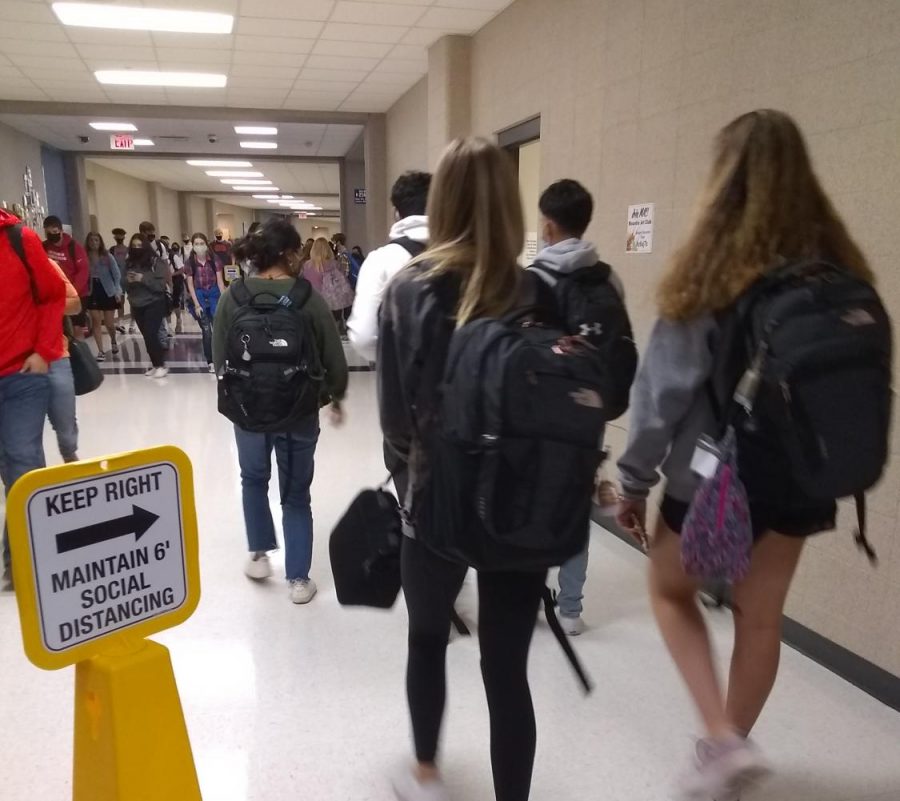PANDEMIC PANDEMONIUM
The school’s precautions are numerous, but quantity never beats quality.
Class is back in session. Masks hide the faces of our peers and sanitizer has become a back-to-school necessity, all to prevent the spread of COVID-19; but it may all be for nothing.
The measures being taken are well known: the teachers spray and wipe down all surfaces with a sanitizing solution, dividers are placed on tables where students share work, and of course, wearing a mask is required.
Safety has become of the utmost importance this school year, but are we really doing all that we can? And is it enough? As students, we need to feel safe at the place in which we spend most of our time. Some students prefer the guaranteed safety of learning within their own home.
“I definitely feel safer at home, mainly because all the while the school tries its hardest to set boundaries, a large population of students are not respecting them properly,” said Maria Solis, 10.
On the other hand, several students have concerns, but still feel the need for a dedicated learning environment.
The amount of precautions does make me feel safer, but there are some students who don’t take it seriously,” said Mikayla Foster, 10.
While prevention efforts are certainly being made, all of the precautions taken in the classroom become pointless when the bell rings and students gather in the futilely divided hallways. Students are huddled together on the right side of the barrier cones, brushing against each other’s shoulders, certainly transferring germs and sharing contaminated air.
Transitioning students between classes using a two-way traffic system has been shown to be the best solution, said assistant principal, Paul Wilson. That way, students are not facing each other, but temporarily side by side with the appropriate face coverings.
While using yellow cones to direct a flow of traffic is a start, asking more than 1,000 students to rush through the crowded hallways and scurry to class in a five minute time frame, seven times a day, seems not only ridiculous, but counterproductive. A more effective strategy for approaching in-person learning at the high school level would have been at the very least to set a block schedule, which would reduce the amount of students in the hallways as well as the overall contact.
Some students have their own suggestions for improving the safety at school.
This is not the best way of transitioning, Solis said. There should be two traveling periods. One group of students should be given sufficient time to get to their next class, then the second set should be released and the process would repeat, Solis said.
Likewise, at the end of the day, dismissal for students is staggered. We are segregated based on our methods of transportation. One minute prevents the bus riders and drivers from leaving at the same time, in hopes of limiting the number of students exiting all at once. It’s a good theory, assuming everyone will follow the rules and wait for their designated dismissal, but there are several eager students who can’t wait to get home and will impersonate drivers or walkers.
“If we are going to have staggered dismissal times,” said Jennifer Arbuckle, long term sub in our district, “Then there needs to be more than one minute between them. If the point is to prevent the spread of COVID, one minute does not give one group enough time to get out of the building and to allow the next group to go. It is not enough time to keep everyone safe.”
As of October, 8, there have been 105 students and staff personnel that have tested positive in the Rogers Schools District for COVID-19. Thirty seven of the 105 are currently active. This goes to show that no matter how many or how severe the precautions are during our 48-minute class periods, acquiring the virus is still a plausible possibility within the walls of the school building and not enough is being done at Rogers High School to protect students.
Parents of the students that tested positive notify the school and its out of our hands from there, said Stacy Moulder, school nurse.
If students and staff are being exposed during any activity outside or within the school, our measures could potentially be considered moot. While they are keeping us relatively safe during class time, we are still exposed during transitions times and again at 3:34 p.m. when the entire school exits the building. Thus, it is impossible to feel even relatively safe at school.
If students don’t follow proper precautions outside of the building, it’s out of the school’s hands and it is their choice, Wilson said.








Jennifer Arbuckle • Oct 19, 2020 at 8:54 am
I would like to add some context to my quote. While I do think that if were are to stagger dismissal, it would be better to do so in, say five minute increments, two major changes would have to take place:
1. More time would have to be allotted to 7th hour. If you have ever worked with scheduling, this is an ENORMOUS task that would be nearly impossible to change.
2. Students would have to be honest about their time to leave. As it stands, all but two of my students leave at 3:31. The author of this op-ed and one other young lady in my 7th hour class stay until the bell rings.
I do not question each student if he or she is riding a bus, being picked up, riding with a friend or driving him/herself.
Thank you for reading my additional comment.